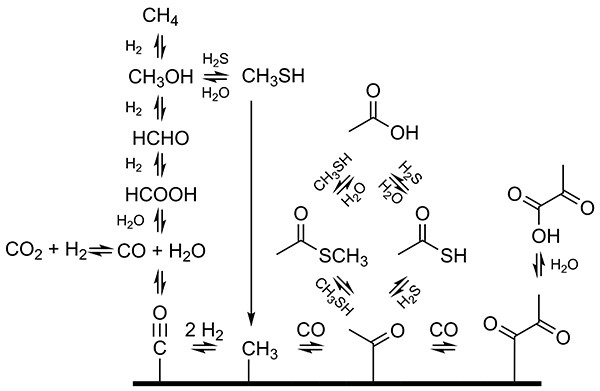Kinetic and thermodynamic considerations reported by researchers at the Tokyo Institute of Technology suggest that thioesters at the heart of many theories on the origin of life are unlikely primordial contributors.
How life emerged from a primordial soup of simple chemicals remains unknown. However scientists have proposed several possible schemes for the origin of life, many of which rely on chemistry involving thioesters such as thioacetic acid (TAA) and methylathioacetate (MTA). Now results of kinetic and thermodynamic considerations reported by Kuhan Chandru and his colleagues at the Tokyo Institute of Technology, question the likelihood of these schemes.
Many of the reactions that form biological matter require enzymes that would not have existed in prebiotic times. However, the high temperatures in hydrothermal vents can overcome reaction barriers without the need for enzymes, making them widely considered likely sites for the origin of life. With this in mind, Chandru along with colleagues led by Jim Cleaves - a researcher affiliated with Tokyo Institute of Technology in Japan and the Institute for Advanced Study in Princeton, - studied the reaction kinetics in the conditions found in hydrothermal vents.
The researchers used nuclear magnetic resonance (NMR) to study the reversible hydrolysis of TAA and MTA in a range of possible pH, temperature and concentration conditions common to hydrothermal settings. They conclude that "TAA and MTA differ significantly in terms of their stability and reactivity as a function of pH and temperature, though both are implausible prebiotic reagents for different reasons in different contexts."
The researchers also add that the results suggest "estimates of the ubiquity of suitable environments for the origin of life in and beyond our solar system may be somewhat overestimated, if these compounds are indeed crucial for jumpstarting early metabolism."
Background
The role of temperature
Chemical reactions can involve the release (exothermal) or absorption (endothermal) of energy. Many of the reactions that produce organic matter in organisms are highly endothermal. They are achieved in living organisms despite the presence of a large energy barrier to product formation thanks to enzymes, which provide a pathway with a lower energy barrier. In prebiotic Earth such enzymes would not be available so very high temperatures, like those found in hydrothermal vents, may have been needed.
TAA and MTA hydrolyze to form acids and thiols. While this reaction is reversible, the equilibrium concentrations of TAA and MTA in the conditions that exist in hydrothermal vents are extremely low for schemes that base the origin of life on these chemicals.
The role of concentration
The exact conditions during the emergence of life on primordial Earth are unknown. However what is known of the ancient oceans during the Archaen period (~4-2.5 x 109 years ago, when life is thought to have begun) constrain concentrations of hydrogen ions (that is, pH) as well as iron, carbon and sulphur to levels similar to those found in hydrothermal vents. These concentrations are all problematic for the generation of TAA and MTA.
The origin of reactants
The product of the hydrolysis reactions is acetic acid. Isotopic measurements to date all point to biological origins of the acetic acid that exists in hydrothermal vents, which leaves questions over its existence in the primordial conditions present during the emergence of life.
Figure. Some proposed mechanisms for the abiotic production of TAA and MTA in hydrothermal settings. The thick line represents a mineral surface (e.g., a metal sulfide or oxide).
Reference
Authors: |
Kuhan Chandru1, Alexis Gilbert1, Christopher Butch1, Masashi Aono1, H. James Cleaves II1,2,3,4* |
Title of original paper: |
The Abiotic Chemistry of Thiolated Acetate Derivatives and the Origin of Life |
Journal: |
Scientific Reports |
DOI : |
|
Affiliations : |
1 Earth-Life Science Institute, Tokyo Institute of Technology
2 Institute for Advanced Study
3 Blue Marble Space Institute of Science
4 Center for Chemical Evolution, Georgia Institute of Technology |
. Any information published on this site will be valid in relation to Science Tokyo.



